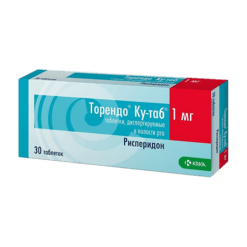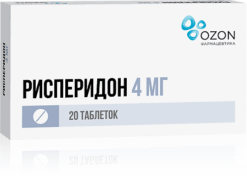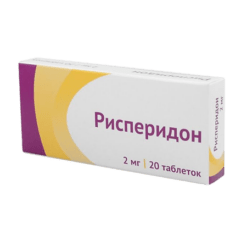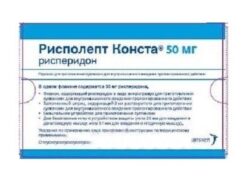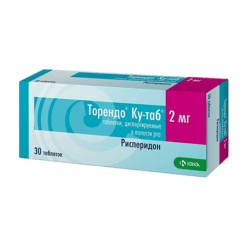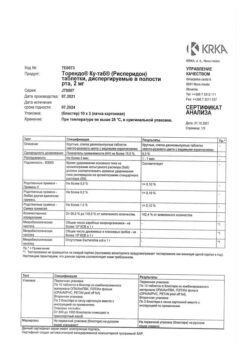No products in the cart.
Risperidone-SZ, 4 mg 30 pcs
€1.00
Out of stock
(E-mail when Stock is available)
Description
Antipsychotic agent (neuroleptic)
ATX code: [N05AX08]
Pharmacodynamics
Risperidone is an antipsychotic agent, a benzisoxazole derivative, also has sedative, antiemetic and hypothermic effects.
Risperidone is a selective monoaminergic antagonist and has high affinity for serotonergic 5-HT2 and dopaminergic B2 receptors. Risperidone also binds to a,-adrenergic receptors and, somewhat weaker, to Hg receptors and a2-adrenergic receptors. Risperidone has no tropism to cholinergic receptors. Antipsychotic action is caused by blockade of 02-dopa-minergic receptors of mesolimbic and mesocortical system.
Risperidone reduces productive symptomatology of schizophrenia (delirium, hallucinations), aggressiveness, automatism, and induces catalepsy to a lesser extent than typical neuroleptics. Balanced central antagonism to serotonin and dopamine may reduce the propensity for extrapyramidal side effects and extend the therapeutic effects of the drug to include negative and affective symptoms of schizophrenia.
Clinical Data Schizophrenia
The efficacy of risperidone in the short-term treatment of schizophrenia has been demonstrated in four studies of 4 to 8 weeks in which 2500 patients meeting DSM-IV criteria for schizophrenia were included. In the 6-week placebo-controlled study, when titrated to a dose of 10 mg/d twice daily, risperidone outperformed placebo on the Brief Psychiatric Rating Scale (BPRS).
In a 6-week placebo-controlled study using risperidone at four fixed doses (2, 6, 10, and 16 mg/day, twice daily), group 4 risperidone was more effective than placebo on the positive and negative syndrome assessment scale (PANSS). In an 8-week comparison study of five fixed-dose risperidone (1,4,8,12, and 16 mg/day, 2 times daily), risperidone in the 4,8, and 16 mg/day groups was more effective than risperidone 1 mg/day on the PANSS scale. In a 4-week placebo-controlled comparative study of two fixed-dose risperidone (4 and 8 mg/d, once daily), risperidone in both groups was more effective than placebo on several PANSS scale items.
Manic episodes in bipolar disorder
The efficacy of risperidone in the monotherapy of acute manic episodes in bipolar disorder type I has been demonstrated in three double-blind, placebo-controlled studies involving approximately 820 patients with bipolar disorder
The DSM-IV Scale Type 1. In these three studies, risperidone at doses of 1-6 mg/day (a starting dose of 3 mg in two studies and 2 mg in one study) was statistically superior to placebo for the primary endpoint, that is, the change in Yang Mania Rating Scale (YMRS) score after 3 weeks compared to baseline. The results for the secondary efficacy endpoints were generally consistent with those for the primary endpoint. The percentage of patients with a reduction of > 50% of the YMRS score after 3 weeks compared to baseline was significantly higher for risperidone than in the placebo group.
The efficacy of risperidone in combination with mood regulators in treating mania has been demonstrated in two 3-week double-blind studies on approximately 300 patients meeting DSM-IV criteria for bipolar disorder type 1. In the 3-week study, risperidone at doses ranging from 1 to 6 mg/day, the starting dose
2 mg/day, in combination with lithium or valproate was more effective than lithium or valproate only at the end of the study on the primary criterion set, that is, on the change in the YMRS score sum compared with baseline at week 3.
Long-term aggression in dementia
The effectiveness of risperidone in treating psycho-behavioral symptoms of dementia, including behavioral problems such as aggression, agitation, psychosis, activity and affective disorders has been demonstrated in three double-blind, placebo-controlled studies on 1,150 patients with moderate to severe dementia. One study was conducted at fixed doses of 0.5,1 and 2 mg/day. Two studies examined unfixed doses, including groups with risperidone doses of 0.5 to 4 mg/d and 0.5 to 2 mg/d, respectively. Risperidone has shown clinically and statistically high efficacy in treating aggression and, to a lesser extent, agitation and psychosis in older patients with dementia (as measured by the Behavioral Abnormality in Alzheimer’s Disease scale (BEHAVE-AD) and the Cogen Mansfield Questionnaire for Agitation (CMAI)).
The efficacy of risperidone in the short-term treatment of aggressive behavior has been demonstrated in placebo-controlled studies in approximately 240 patients aged 5 to 12 years with DSM-IV disruptive behavior disorders and intellectual functioning below average or with mild mental retardation or moderate learning disabilities. In both studies, risperidone at doses of 0.02 to 0.06 mg/kg/day was significantly more effective than placebo on the prespecified primary efficacy endpoint.
Pharmacokinetics
Risperidone is completely absorbed after oral administration, reaching maximum plasma concentrations in 1-2 hours. The absolute oral bioavailability of risperidone is 70%.
Food has no effect on the absorption of risperidone, therefore it can be prescribed regardless of meals.
Risperidone is rapidly distributed in the body. The volume of distribution is 1-2 l/kg. In plasma, risperidone is bound to albumin and alpha-acid glycoprotein. Risperidone is 90% bound to plasma proteins, 9-hydroxysperidone – 77%. The equilibrium concentration of risperidone in the body in most patients is reached within 1 day. The equilibrium concentration of 9-hydroxysperidone is reached in 4-5 days. Plasma concentrations of risperidone are proportional to the dose of the drug (within therapeutic doses).
Risperidone is metabolized by the CYP2D6 isoenzyme to 9-hydroxy-risperidone, which has similar pharmacological effects to risperidone. Risperidone and 9-hydroxyrisperidone constitute the active antipsychotic fraction. Metabolism depends on the genetic polymorphism of the CYP2D6 isoenzyme.
The other route of metabolism of risperidone is N-dealkylation.
After oral administration in patients with psychosis, risperidone is excreted with a half-life (T1/2) of about 3 hours. The T1/2 of 9-hydroxysperidone and the active antipsychotic fraction is 24 hours.
After a week of taking the drug, 70% of the dose is excreted in the urine, 14% in the feces. In the urine, risperidone plus 9-hydroxyrisperidone make up 3545% of the dose. The remaining amount consists of inactive metabolites.
Particular patient groups
A single-dose study of the drug found higher plasma concentrations and slower excretion in the elderly and in patients with renal impairment. Plasma concentrations of risperidone in patients with hepatic impairment were normal.
The pharmacokinetics of risperidone and 9-hydroxirisperidone in pediatric patients are similar to those in adult patients.
There is no effect of sex, ethnicity or smoking on the pharmacokinetics of risperidone.
Indications
Indications
Treatment of schizophrenia.
Treatment of manic episodes in moderate to severe bipolar disorder.
Short-term (up to 6 weeks) treatment of persistent aggression in patients with moderate to severe dementia due to Alzheimer’s disease – when non-pharmacological correction methods are ineffective and there is a threat of harm to the patient or others. Short-term (up to 6 weeks) symptomatic treatment of persistent aggression in behavior disorder in children 5-16 years old with moderate and severe mental retardation, the severity of which requires pharmacological correction methods (as part of complex therapy).
Pharmacological effect
Pharmacological effect
Antipsychotic (neuroleptic)
ATX code: [N05AX08]
Pharmacodynamics
Risperidone is an antipsychotic drug, a benzisoxazole derivative, which also has sedative, antiemetic and hypothermic effects.
Risperidone is a selective monoaminergic antagonist with high affinity for serotonergic 5-HT2 and dopaminergic L2 receptors. Risperidone also binds to α-adrenergic receptors and, somewhat weaker, to Hg-histaminergic and α2-adrenergic receptors. Risperidone does not have tropism for cholinergic receptors. The antipsychotic effect is due to the blockade of 02-dopaminergic receptors of the mesolimbic and mesocortical systems.
Risperidone reduces the productive symptoms of schizophrenia (delusions, hallucinations), aggressiveness, automatism, and induces catalepsy to a lesser extent than typical antipsychotics. Balanced central antagonism of serotonin and dopamine may reduce the propensity for extrapyramidal side effects and expand the therapeutic effect of the drug to cover the negative and affective symptoms of schizophrenia.
Clinical data Schizophrenia
The effectiveness of risperidone in the short-term treatment of schizophrenia was demonstrated in four studies lasting 4 to 8 weeks, which included 2500 patients meeting DSM-IV criteria for schizophrenia. In a 6-week placebo-controlled study, when titrated to a dose of 10 mg/day twice daily, risperidone was superior to placebo on the Brief Psychiatric Rating Scale (BPRS).
In a 6-week placebo-controlled study using risperidone at four fixed doses (2, 6, 10 and 16 mg/day, twice daily), in group 4, risperidone was more effective than placebo on the Positive and Negative Syndrome Scale (PANSS). In an 8-week comparative study of five fixed doses of risperidone (1, 4, 8, 12 and 16 mg/day, twice daily), risperidone in the 4,8 and 16 mg/day groups was more effective than risperidone 1 mg/day on the PANSS scale. In a 4-week comparative placebo-controlled study of two fixed doses of risperidone (4 and 8 mg/day, once daily), risperidone in both groups was more effective than placebo on several items of the PANSS scale.
Manic episodes in bipolar disorder
The effectiveness of risperidone as monotherapy for acute manic episodes in bipolar I disorder was demonstrated in three double-blind, placebo-controlled studies involving approximately 820 patients with bipolar disorder.
Type 1, according to the DSM-IV scale. In these three studies, risperidone at doses of 1–6 mg/day (initial dose 3 mg in two studies and 2 mg in one study) was statistically superior to placebo in the primary endpoint of change from baseline in Young Mania Rating Scale (YMRS) score at 3 weeks. Results for secondary efficacy endpoints were generally consistent with results for the primary endpoint. The percentage of patients with a >50% reduction in YMRS score at 3 weeks from baseline was significantly higher for risperidone than for placebo.
The effectiveness of risperidone in combination with mood regulators in the treatment of mania was demonstrated in two three-week, double-blind studies in approximately 300 patients meeting DSM-IV criteria for bipolar disorder type 1. In a 3-week study, risperidone at doses ranging from 1 to 6 mg/day, initial dose
2 mg/day, in combination with lithium or valproate, was more effective than lithium or valproate only at the end of the study on the primary endpoint, that is, change from baseline in YMRS score at week three.
Long-term aggression in dementia
The effectiveness of risperidone in the treatment of psycho-behavioral symptoms of dementia, including behavioral problems such as aggression, agitation, psychosis, activity and mood disorders, was demonstrated in three double-blind, placebo-controlled studies in 1150 patients with moderate to severe dementia. One study was conducted at fixed doses of 0.5, 1 and 2 mg/day. Two studies examined non-fixed doses, including groups with risperidone doses of 0.5 to 4 mg/day and 0.5 to 2 mg/day, respectively. Risperidone has been shown to be clinically and statistically highly effective in the treatment of aggression, and, to a lesser extent, agitation and psychosis in elderly patients with dementia (as measured by the Behavioral Pathology in Alzheimer’s Disease (BEHAVE-AD) scale and the Cohen Mansfield Agitation Inventory (CMAI)).
Behavioral disorders
The effectiveness of risperidone in the short-term treatment of aggressive behavior was demonstrated in placebo-controlled studies in approximately 240 patients aged 5 to 12 years with DSM-IV disruptive behavior disorder and below average intellectual functioning or mild mental retardation or moderate learning disabilities. In both studies, risperidone at doses of 0.02 to 0.06 mg/kg/day was significantly more effective than placebo on the prespecified primary efficacy endpoint.
Pharmacokinetics
Risperidone is completely absorbed after oral administration, reaching maximum plasma concentrations within 1-2 hours. The absolute oral bioavailability of risperidone is 70%.
Food does not affect the absorption of risperidone, so it can be administered regardless of food intake.
Risperidone is rapidly distributed in the body. The volume of distribution is 1-2 l/kg. In plasma, risperidone binds to albumin and alpha-acid glycoprotein. Risperidone is 90% bound to plasma proteins, 9-hydroxyrisperidone is 77% bound. The equilibrium concentration of risperidone in the body is achieved within 1 day in most patients. The equilibrium concentration of 9-hydroxyrisperidone is achieved after 4-5 days. Plasma concentrations of risperidone are proportional to the dose of the drug (within therapeutic doses).
Risperidone is metabolized by the CYP2D6 isoenzyme to 9-hydroxy-risperidone, which has a pharmacological effect similar to risperidone. Risperidone and 9-hydroxyrisperidone constitute the active antipsychotic fraction. Metabolism depends on the genetic polymorphism of the CYP2D6 isoenzyme.
Another route of metabolism for risperidone is N-dealkylation.
After oral administration in patients with psychosis, risperidone is eliminated from the body with a half-life (T1/2) of about 3 hours. T1/2 of 9-hydroxyrisperidone and the active antipsychotic fraction is 24 hours.
After a week of taking the drug, 70% of the dose is excreted in the urine, 14% in feces. In urine, risperidone plus 9-hydroxyrisperidone constituted 3545% of the dose. The remaining amount consists of inactive metabolites.
Special patient groups
A single-dose study showed higher plasma concentrations and slower elimination in the elderly and in patients with renal impairment. Plasma concentrations of risperidone were normal in patients with hepatic impairment.
The pharmacokinetics of risperidone and 9-hydroxyrisperidone in pediatric patients are similar to those in adult patients.
There is no effect of gender, nationality or smoking on the pharmacokinetics of risperidone.
Special instructions
Special instructions
Transition from therapy with other antipsychotic drugs. In case of schizophrenia, at the beginning of treatment with Risperidone-SZ, it is recommended to gradually discontinue previous therapy if clinically justified. Moreover, if patients are transferred from depot therapy with antipsychotic drugs, it is recommended to begin therapy with Risperidone-SZ instead of the next scheduled injection. The need to continue current antiparkinsonian drug therapy should be periodically assessed.
Use in elderly patients with dementia. Elderly patients with dementia treated with atypical antipsychotics experienced increased mortality compared with placebo in studies of atypical antipsychotics, including risperidone. When using risperidone in this population, the incidence of death was 4.0% for patients taking risperidone compared with 3.1% for placebo. The mean age of patients who died was 86 years (range, 67–100 years).
For older patients with dementia taking oral risperidone, there was increased mortality in patients taking furosemide and risperidone (7.3%, mean age 89 years, range 75-97 years) compared with the risperidone-only group (3.1%, mean age 84 years, range 70-96 years) and the furosemide-only group (4.1%, mean age 80 years, range 67-90 years). No pathophysiological mechanisms have been established to explain this observation. However, special care should be taken when prescribing the drug in such cases. There was no increase in mortality in patients taking other diuretics concomitantly with risperidone. Regardless of treatment, dehydration is a common risk factor for mortality and should be carefully monitored in older patients with dementia.
Cerebrovascular disorders
In patients with dementia treated with atypical antipsychotics, there was an approximately 3-fold increase in the risk of cerebrovascular adverse reactions in randomized placebo-controlled clinical trials. A pooled analysis of six placebo-controlled studies of risperidone, mainly in elderly patients (over 65 years of age) with dementia, found that cerebrovascular adverse reactions (serious, non-serious, combined) occurred in 3.3% (33/1009) of patients receiving risperidone and in 1.2% (8/712) of patients receiving placebo. Odds ratio 2.96 (95% confidence interval). The mechanism of this risk has not been studied. An increased risk cannot be excluded with other antipsychotic drugs and other patient groups. Risperidone should be used with caution in patients with risk factors for stroke.
The risk of developing adverse cerebrovascular reactions is significantly higher in patients with mixed or vascular dementia than in patients with Alzheimer’s dementia. Therefore, risperidone is not recommended for patients with mixed or vascular dementia.
The risks and therapeutic benefits of risperidone in elderly patients with dementia need to be assessed, taking into account patient-specific prognostic risk factors for stroke. The patient and those around him should be warned to urgently report symptoms and signs of potential cerebrovascular adverse reactions, in particular sudden weakness or numbness of the face, upper and lower extremities, speech or vision problems. In this case, all therapeutic options, including discontinuation of risperidone, are urgently considered.
For persistent aggression in patients with Alzheimer’s dementia, risperidone is intended only for short-term use as an adjunct to non-pharmacological measures when they are ineffective or limited and there is no potential danger to the patient or his environment. Constant monitoring and assessment of the patient’s condition is necessary, as well as justification for the need for further treatment.
Orthostatic hypotension. Due to the α-blocking effect of risperidone, orthostatic hypotension may occur, especially during the initial dose titration period. A clinically significant decrease in blood pressure is observed when risperidone is coadministered with antihypertensive drugs. If blood pressure decreases, a dose reduction should be considered. In patients with diseases of the cardiovascular system, as well as in cases of dehydration, hypovolemia or cerebrovascular disorders, the dose should be increased gradually, as recommended.
Leukopenia, neutropenia, agranulocytosis
Leukopenia, neutropenia and agranulocytosis were observed with the use of antipsychotics, incl. when using the drug Risperidone-SZ. Agranulocytosis has been observed very rarely during post-marketing surveillance. In patients with a history of a clinically significant decrease in white blood cell count or drug-related leukopenia/neutropenia, a complete blood count is recommended during the first months of therapy, and discontinuation of treatment with Risperidone-SZ should be considered at the first clinically significant decrease in the white blood cell count in the absence of other possible causes. Patients with clinically significant neutropenia are advised to be monitored for fever or symptoms of infection and to initiate treatment immediately if such symptoms occur. Patients with severe neutropenia (absolute neutrophil count less than 1 x 109/L) should discontinue use of Risperidone-SZ until the white blood cell count normalizes.
Venous thromboembolism
Cases of venous thromboembolism have been reported with the use of antipsychotic drugs. Since patients taking antipsychotic drugs are often at risk of developing venous thromboembolism, all possible risk factors should be identified before and during treatment with Risperidone-SZ and preventive measures should be taken.
Tardive dyskinesia and extrapyramidal disorders
Drugs with dopamine receptor antagonist properties can cause tardive dyskinesia, which is characterized by rhythmic involuntary movements, mainly of the tongue and/or facial muscles. There are reports that the occurrence of extrapyramidal symptoms is a risk factor for the development of tardive dyskinesia. Risperidone is less likely to cause extrapyramidal symptoms than classic antipsychotics. If signs and symptoms of tardive dyskinesia occur, discontinuation of all antipsychotic medications should be considered.
Neuroleptic malignant syndrome
In the event of the development of neuroleptic malignant syndrome, characterized by hyperthermia, muscle rigidity, instability of autonomic functions, impaired consciousness and increased activity of creatine phosphokinase (myoglobinuria (rhabdomyolysis) and acute renal failure can also be observed), it is necessary to discontinue all antipsychotic drugs, including Risperidone-SZ.
Parkinson’s disease and dementia with Lewy bodies
Antipsychotic medications, including Risperidone-SZ, should be prescribed with caution to patients with Parkinson’s disease or dementia with Lewy bodies. Both groups of patients have an increased risk of developing neuroleptic malignant syndrome and increased sensitivity to antipsychotic drugs (including dullness of pain sensitivity, confusion, postural instability with frequent falls and extrapyramidal symptoms).
Hyperglycemia and diabetes mellitus
When treated with Risperidone-SZ, hyperglycemia, development of diabetes mellitus and exacerbation of existing diabetes mellitus were observed. Establishing a relationship between the use of atypical antipsychotic drugs and impaired glucose metabolism is complicated by the increased risk of developing diabetes mellitus in patients with schizophrenia and the prevalence of diabetes mellitus in the general population. Given these factors, the relationship between the use of atypical antipsychotic drugs and the development of side effects associated with hyperglycemia is not fully established. All patients should be clinically monitored for symptoms of hyperglycemia and diabetes mellitus.
diabetes, (see section “Side effects”),
Hyperprolactinemia
Tissue culture studies have shown that cell growth in breast tumors can be stimulated by prolactin. Risperidone should be used with caution in patients with hyperprolactinemia and in patients with potentially prolactin-dependent tumors.
Weight gain
During treatment with Risperidone-SZ, a significant increase in body weight was observed. It is necessary to monitor the body weight of patients during therapy with Risperidone-SZ. QT interval prolongation
As with other antipsychotics, caution should be exercised when prescribing Risperidone-SZ to patients with a history of cardiac arrhythmias, patients with congenital prolongation of the QT interval, and when used concomitantly with drugs that prolong the QT interval.
Priapism
Drugs with alpha-blocking effects can cause priapism. In post-marketing studies of the drug Risperidone-SZ, reports of the development of priapism were received.
Body temperature regulation
Antipsychotic drugs are associated with such an undesirable effect as interfering with the body’s ability to regulate body temperature. Caution should be exercised when prescribing Risperidone-SZ to patients with conditions that may contribute to an increase in core body temperature, such as intense physical activity, dehydration, exposure to high external temperatures, or concomitant use of drugs with anticholinergic activity.
Antiemetic effect
Preclinical studies have demonstrated the antiemetic effect of risperidone. This effect, when observed in humans, may mask objective and subjective symptoms of overdose of some drugs, as well as diseases such as intestinal obstruction, Reye’s syndrome, and brain tumors.
Seizure activity threshold
The ability of typical antipsychotics to lower the threshold of seizure activity is known. Risperidone-SZ should be prescribed with caution to patients with epilepsy.
Withdrawal syndrome
When stopping treatment, a gradual dose reduction is recommended. Withdrawal symptoms: Nausea, vomiting, sweating and insomnia have been very rarely described when high-dose antipsychotic medications are abruptly stopped.
Children and teenagers
The sedative effect of risperidone should be carefully monitored; it is possible to change the time of taking Risperidone-SZ.
Body weight should be monitored. Regular assessment of endocrine function, extrapyramidal symptoms, and movement disorders is required.
Active ingredient
Active ingredient
Risperidone
Composition
Composition
1 film-coated tablet contains:
Active substance:
risperidone – 4 mg
Excipients (core): lactose monohydrate (milk sugar) – 114.0 mg; microcrystalline cellulose – 19.7 mg; pregelatinized corn starch (Starch 1500) – 3.0 mg; magnesium stearate – 1.0 mg; potato starch – 11.0 mg; povidone (medium molecular weight polyvinylpyrrolidone) – 7.3 mg.
Shell composition:
Opadry II – 5 mg (polyvinyl alcohol, partially hydrolyzed – 2.2000 mg; talc – 1.0000 mg; macrogol (polyethylene glycol 3350) – 0.6175 mg; titanium dioxide E 171 – 0.6545 mg; soy lecithin E 322 – 0.1750 mg; aluminum varnish based yellow quinoline – 0.1010 mg; aluminum varnish based on indigo carmine – 0.2520 mg).
Pregnancy
Pregnancy
There is no data on the safety of risperidone in pregnant women. In animal experiments, risperidone did not have a direct toxic effect on the reproductive system, but caused some indirect effects mediated through prolactin and the central nervous system. In none of the studies did risperidone have a teratogenic effect. If a woman took antipsychotic drugs (including Risperidone-SZ) in the third trimester of pregnancy, the newborns are at risk of extrapyramidal disorders and/or withdrawal syndrome of varying severity. These symptoms may include agitation, hypertension, hypotonia, tremor, somnolence, respiratory distress, and feeding problems.
Risperidone-SZ can be used during pregnancy only in cases where the potential benefit to the woman outweighs the possible risk to the fetus.
Because risperidone and 9-hydroxyrisperidone are excreted in breast milk, women using Risperidone-SZ should not breast-feed.
Contraindications
Contraindications
– individual hypersensitivity to risperidone or any other ingredient of this drug;
– lactase deficiency, lactose intolerance, glucose-galactose malabsorption;
– for the treatment of persistent aggression in behavior disorder in children with moderate and severe mental retardation, children under 5 years of age (experience of use is insufficient),
– for other indications, children under 18 years of age.
WITH CAUTION
Use with caution in the following conditions:
– diseases of the cardiovascular system (chronic heart failure, previous myocardial infarction, cardiac muscle conduction disorders);
– dehydration and hypovolemia;
– cerebrovascular accidents;
– Parkinson’s disease,
– convulsions and epilepsy (including a history);
– severe renal or hepatic failure (see section “Method of administration and dosage”),
– drug abuse or drug dependence (see section “Method of administration and dosage”);
– conditions predisposing to the development of tachycardia of the “pirouette” type (bradycardia, electrolyte imbalance, concomitant use of drugs that prolong the QT interval):
– brain tumor, intestinal obstruction, cases of acute drug overdose, Reis syndrome (the antiemetic effect of risperidone may mask the symptoms of these conditions):
– pregnancy and lactation period.
Side Effects
Side Effects
Side effects of the drug Risperidone-SZ in therapeutic doses are given with a distribution by frequency and system-organ classes. The frequency of side effects was classified as follows: very common (*1/10 cases), common (>1/100 and 1/1000 and 1/10000 and <1/1000 cases) and very rare (<1/10000 cases).
InLekiii:
very often – in elderly patients with dementia – urinary tract infections; often – nasopharyngitis, upper respiratory tract infections, bronchitis, sinusitis, urinary tract infections, rhinitis, influenza-like diseases: in elderly patients with dementia – pneumonia, phlegmon;
uncommon – ear infections, viral infections, tonsillitis, eye infections, localized infections, cystitis, onychomycosis, acrodermatitis, respiratory tract infections.
Hematological and lymphatic disorders
uncommon – thrombocytopenia, anemia, neutropenia, leukopenia, decreased hematocrit;
rarely – granulocytopenia, agranulocytosis
From the stolons of the immune system:
uncommon – hypersensitivity;
very rarely – anaphylactic reactions, anaphylactic shock.
From the endocrine system: often – hyperprolactinemia;
rarely – impaired secretion of antidiuretic hormone, diabetic coma.
Metabolic and nutritional disorders:
often – increased appetite, in elderly patients with dementia – decreased appetite; infrequently – polydipsia, anorexia, diabetes mellitus: rarely – hypoglycemia, water intoxication; very rarely – diabetic ketoacidosis.
Mental disorders: very often – insomnia;
often – anxiety, sleep disturbances, nervousness, lethargy, in elderly patients with dementia – confusion;
infrequently – flattening of affect, mania, weakened libido, depression, nightmares; very rarely – anorgasmia.
From the nervous system:
very often – parkinsonism (hypersalivation, cogwheel syndrome, akinesia, bradykinesia, hypokinesia, musculoskeletal rigidity, mask-like face), drowsiness, headaches, sedation, dizziness;
often – akathisia (including restlessness), tremor, dystonia (including muscle spasms, involuntary muscle contractions, muscle contracture, involuntary movements of the eyeballs, tongue paralysis), lethargy, postural dizziness, dyskinesia (including muscle twitching, chorea and choreoathetosis), dysarthria, drooling, impaired attention, gait disturbance, increased drowsiness; in elderly patients with dementia – depressed state, drooling, cerebrovascular disorders; uncommon – lack of response to stimuli, impaired coordination of movements, loss of consciousness, fainting, speech impairment, hypoesthesia, paresthenesia, psychomotor hyperactivity, tardive dyskinesia, cerebrovascular disorders;
rarely – neuroleptic malignant syndrome, extrapyramidal symptoms (tremor, rigidity, hypersalivation, bradykinesia, akathisia, acute dystonia), rhythmic head nodding.
Ophthalmological disorders:
often – decreased visual acuity, in elderly patients with dementia – conjunctivitis; uncommon – conjunctival hyperemia, involuntary rotation of the eyeballs, crust formation on the edges of the eyelids, dry eyes, increased lacrimation, photophobia, increased intraocular pressure.
From the ear and labyrinth:
uncommon – tinnitus, ear pain, vertigo, chronic otitis media.
From the cardiovascular system
often – tachycardia, orthostatic hypotension, decreased blood pressure, palpitations, in elderly patients with dementia – transient ischemic attack; uncommon – bradycardia, sinus arrhythmia, atrial fibrillation, atrioventricular block, flushing, cardiac muscle conduction disturbances; very rarely – deep vein thrombosis, pulmonary embolism, venous thromboembolism. Respiratory, thoracic and mediastinal disorders: often – nasal congestion, shortness of breath, nosebleeds, sinus congestion, cough, rhinorrhea, pain in the larynx and pharynx, pulmonary congestion, in elderly patients with dementia – cough, rhinorrhea;
uncommon – wheezing, aspiration pneumonia, dysphonia, airway obstruction, moist rales, respiratory failure; rarely – sleep apnea syndrome, hyperventilation.
From the gastrointestinal tract:
often – nausea, constipation, dyspepsia, vomiting, diarrhea, salivation, dry mouth, stomach discomfort, abdominal pain, in elderly patients with dementia – dysphagia, fecaloma; infrequently – fecal incontinence, flatulence, gastroenteritis, toothache, swelling of the tongue, cheilitis. dysgeusia; very rarely – intestinal obstruction, pancreatitis.
Hepatobiliary disorders: rarely – jaundice.
For the skin and subcutaneous tissues:
often – rash, itching, acne, in elderly patients with dementia – erythema;
uncommon – eczema, dry skin, seborrheic dermatitis, hyperkeratosis, pigmentation disorder
skin, skin inflammation, skin damage, angioedema, alopecia;
rarely – dandruff.
From the musculoskeletal system and connective tissue:
often – musculoskeletal pain, back pain, arthralgia, pain in the extremities, myalgia, pain
in the neck, in elderly patients with dementia – gait disturbances, swelling of joints;
infrequently – stiffness in joints, muscle weakness;
rarely – rhabdomyolysis.
From the kidneys and urinary tract: often – urinary incontinence, enuresis, pollakiuria; infrequently – urinary retention, dysuria.
From the reproductive system and mammary glands: often – lack of ejaculation, galactorrhea;
uncommon – menstrual irregularities, amenorrhea, gynecomastia, vaginal discharge, erectile dysfunction, ejaculation disorders, breast enlargement, sexual dysfunction, breast discharge; very rarely – priapism.
Impact on the course of pregnancy, postpartum and perinatal conditions: very rarely – withdrawal syndrome in newborns.
General violations:
often – fatigue, asthenia, fever, chest pain, weight gain, slowness; in elderly patients with dementia – peripheral edema, gait disturbance, mild edema;
infrequently – thirst, decreased temperature, malaise, swelling of the face, chills; rarely – hypothermia, withdrawal syndrome, cold extremities.
Violations of laboratory and instrumental indicators: often – increased heart rate, in elderly patients with dementia – increased body temperature;
infrequently – an increase in the number of eosinophils in the blood, an increase in the activity of creatine phosphokinase, a decrease in the number of leukocytes in the blood, an increase in the activity of liver enzymes, an increase in the activity of gamma-glutamyltransferase, a decrease in hematocrit, an increase in the activity of transaminases, an increase in the concentration of cholesterol in the blood, an increase in the concentration of triglycerides in the blood, granulocytopenia, hyperglycemia, weight loss, prolongation of the QT interval on the electrocardiogram, changes on the cardiogram. Class effects
Very rare cases of QT prolongation have been reported in post-marketing studies of risperidone. In addition, effects such as ventricular arrhythmia, ventricular fibrillation, ventricular tachycardia, sudden death, cardiac arrest, flutter and fibrillation have been noted.
Venous thromboembolism
Cases of venous thromboembolism, including cases of pulmonary embolism, as well as deep vein thrombosis (frequency unknown), have been reported with the use of antipsychotics.
Weight gain
In a 6- to 8-week placebo-controlled study in adult patients with schizophrenia treated with risperidone and placebo, a clinically significant increase in body weight of 7% or more was observed in the risperidone group (18%), which was higher than in the placebo group (9%). In a 3-week placebo-controlled study in adult patients with acute mania, weight gain of 7% or more at the end of the study was adequate in the risperidone (2.5%) and placebo (2.4%) groups and was slightly greater in the control group (3.5%).
In children and adolescents with antisocial symptoms and other behavior disorders in long-term studies, the average body weight increased by 7.3 kg after 12 months of treatment. The expected weight gain in healthy children aged 5-12 years is 3 to 5 kg per year. Girls 12-16 years old gain from 3 to 5 kg per year, and boys about 5 kg per year.
Elderly patients with dementia
Side effects in elderly patients with dementia in clinical trials were: transient ischemic attack, stroke; urinary tract infections, peripheral edema, drowsiness, cough.
Children
The types of adverse reactions in children are similar to those observed in adult patients. The following adverse reactions have been reported at an incidence of 5% in children (5 to 17 years of age) and at least twice the incidence observed in clinical trials in adults:
drowsiness, sedation, fatigue, headache, increased appetite, vomiting, upper respiratory tract infection, nasal congestion, abdominal pain, dizziness, cough, fever, tremor, diarrhea and enuresis.
With long-term treatment with risperidone, the effect on puberty has not been studied.
Interaction
Interaction
Given that Risperidone-SZ primarily affects the central nervous system, it should be used with caution with alcohol, opiates, antihistamines and benzodiazepines due to the increased risk of sedation.
Risperidone reduces the effectiveness of levodopa and other dopamine receptor agonists. However, if concurrent use is necessary, particularly in end-stage Parkinson’s disease, the minimum effective dose of each treatment should be prescribed.
Caution should be exercised when co-administering Risperidone-SZ with drugs that prolong the QT interval, for example, class 1a antiarrhythmic drugs (eg, quinidine, disopyramide, procainamide), class III antiarrhythmic drugs (eg, amiodarone, sotalol), tricyclic antidepressants (amitriptyline), tetracyclic antidepressants (maprotiline), some antihistamines, other antipsychotic drugs, some antimalarials (quinine and mefloquine), and some drugs that cause electrolyte disturbances (hypokalemia, hypomagnesemia), bradycardia, or inhibit the hepatic metabolism of risperidone.
Clozapine reduces the clearance of risperidone.
When using carbamazepine, a decrease in the concentration of the active antipsychotic fraction of risperidone in plasma was observed. Similar effects may be observed when using other inducers of the CYP3A4 isoenzyme and P-glycoprotein. When prescribing and after discontinuation of carbamazepine or other inducers of the CYP3A4/P-glycoprotein isoenzyme, the dose of Risperidone-SZ should be adjusted.
Fluoxetine and paroxetine, inhibitors of the CYP2D6 isoenzyme, increase the plasma concentration of risperidone, but to a lesser extent the concentration of the active antipsychotic fraction. When prescribing and after discontinuation of fluoxetine or paroxetine, the dose of Risperidone-SZ should be adjusted. Other CYP2D6 inhibitors, such as quinidine, may alter plasma concentrations of risperidone in a similar manner.
Verapamil, an inhibitor of the CYP3A4 isoenzyme and P-glycoprotein, increases the plasma concentration of risperidone.
Topiramate moderately reduces the bioavailability of risperidone, but not the active antipsychotic fraction. This interaction is not considered clinically significant. Phenothiazine derivatives, tricyclic antidepressants and some β-blockers may increase plasma concentrations of risperidone, but this does not affect the concentration of the active antipsychotic fraction. Amitriptyline does not affect the pharmacokinetics of risperidone and the active antipsychotic fraction. Cimetidine and ranitidine increase the bioavailability of risperidone, but have a minimal effect on the concentration of the active antipsychotic fraction. Erythromycin, an inhibitor of the CYP3A4 isoenzyme, does not affect the pharmacokinetics of risperidone and the active antipsychotic fraction. Cholinesterase inhibitors (galantamine and donepezil) do not have a clinically significant effect on the pharmacokinetics of risperidone and the active antipsychotic fraction.
When using the drug Risperidone-SZ together with other drugs that are highly bound to plasma proteins, no clinically significant displacement of any drug from the plasma protein fraction is observed.
Antihypertensive drugs increase the degree of blood pressure reduction in the presence of risperidone.
Risperidone does not have a clinically significant effect on the pharmacokinetics of lithium, valproic acid, digoxin or topiramate.
Eating does not affect the absorption of risperidone.
Overdose
Overdose
Symptoms: drowsiness, sedation, tachycardia, decreased blood pressure, extrapyramidal symptoms. QT prolongation and seizures have been observed. Bidirectional ventricular tachycardia has been observed during co-administration of increased doses of risperidone and paroxetine.
In case of overdose, the possibility of overdose from multiple drugs should be considered.
Treatment. An open airway should be achieved and maintained to ensure adequate oxygen supply and ventilation, gastric lavage should be performed (after intubation, if the patient is unconscious) and activated charcoal should be prescribed along with a laxative. ECG monitoring should be started immediately to identify possible arrhythmias.
There is no specific antidote; appropriate symptomatic therapy must be carried out. Decreased blood pressure and collapse should be treated with intravenous fluid infusions and/or sympathomimetic drugs. In case of development of acute extrapyramidal symptoms, m-anticholinergic blockers (for example, trihexyphenidyl) should be prescribed. Constant medical observation and monitoring should be continued until symptoms of intoxication disappear.
Storage conditions
Storage conditions
In a dry place, protected from light, at a temperature not exceeding 25 ° C.
Keep out of reach of children
Shelf life
Shelf life
3 years. Do not use after the expiration date stated on the package.
Manufacturer
Manufacturer
North Star NAO, Russia
Additional information
| Shelf life | 3 years. Do not use after the expiration date printed on the package. |
|---|---|
| Conditions of storage | In a dry, light-protected place at a temperature not exceeding 25 ° C. Store out of the reach of children |
| Manufacturer | North Star NAO, Russia |
| Medication form | pills |
| Brand | North Star NAO |
Other forms…
Related products
Buy Risperidone-SZ, 4 mg 30 pcs with delivery to USA, UK, Europe and over 120 other countries.


